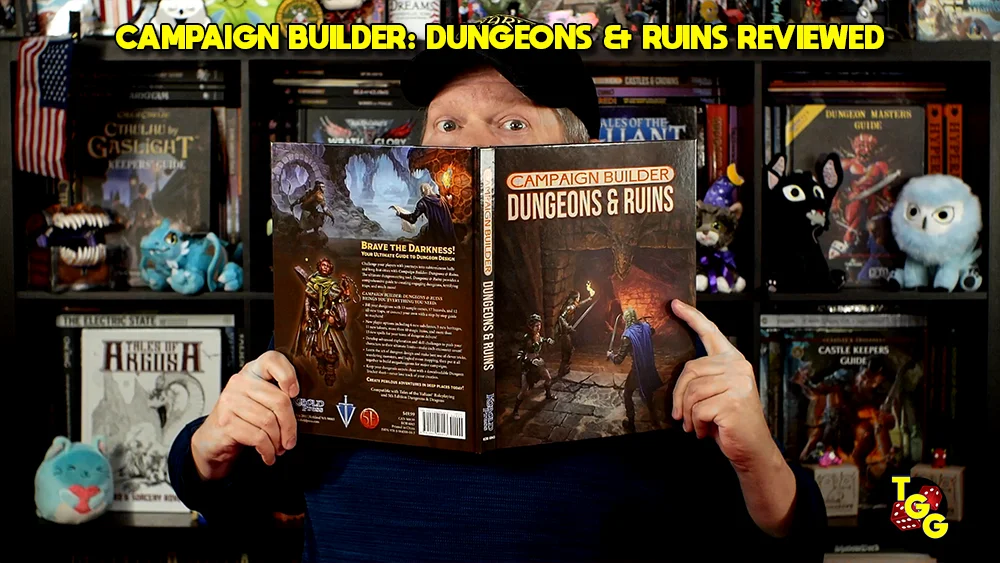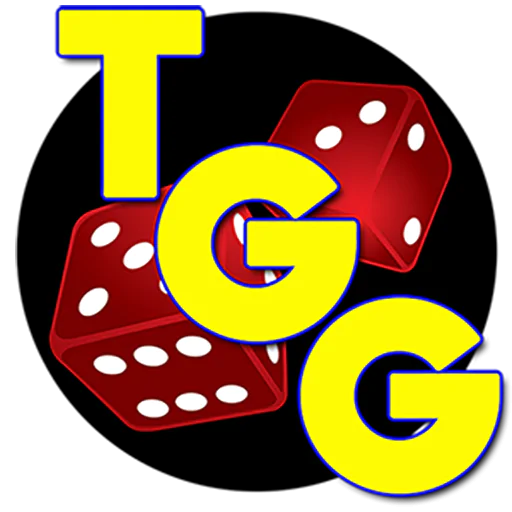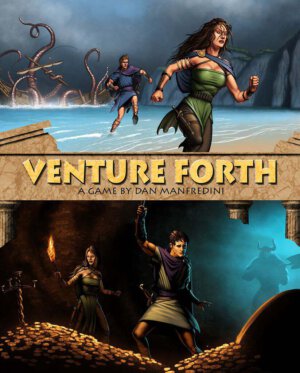
Publisher: Minion Games
Designer: Dan Manfredini
Artist: James Denton
Year: 2011
Genre: Euro-style Board Game
Players: Two to four players
Ages: 13+
Playing Time: 60 Minutes
MSRP: $49.99
From Minion Games:
In Venture Forth, players have a party of adventurers who each have their own personal ambition. Achieving an ambition allows the player to convert that adventurer’s “will” into points and to possibly level him up. All ambitions require the player to venture forth, which means moving his party from one site to another along a path. One of the main actions in the game is playing an enemy or adventurer card to these path spaces. Once a path is completely filled in, any player can choose to venture forth down it and encounter each card one by one, recruiting adventurers, defeating enemies, and possibly gaining treasure along the way. A combination of resource management, path planning, and timing will help you along the way.
Victory Points are used to score in this game, not dice rolls or damage or even the killing of monsters. The more you trigger your adventurers life goals the more VP you get. The more “despair” you receive the hard it is to score well.
Venture Forth is a Greek Mythology adventure game where the goal is to accumulate the most victory points by venturing between temples, gathering adventurers and killing monsters as you go.
The board is double sided to provide different layouts to keep the game fresh. This was a nice touch by Minion Games. There are 22 spaces on the board that basically paths connected by temples. At the start of the game, the paths are free of encounters. Players will be filling the spaces with encounter cards as the game progresses.
The cards are the smaller style, but have some nice thematic artwork. They are made up of monsters and adventurers. 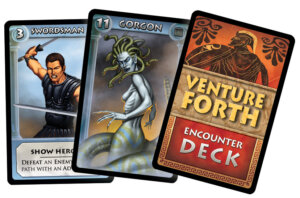
After everyone places their first party member, and pays for them with the coins they received at the start of the game you are ready to begin play. You each have a hand of five cards. Each turn you get to perform one of four different actions.
Play a Card: You may play a card from your hand onto one of the open path spaces on the board. By doing so you are actually placing encounters along the path that a party of adventurers must face as they venture along it. Each space has a symbol on it representing different resources that you receive by placing a card on that space. This will either be a Will cube, a coin, or a combination of these. You might also get to select an explore token. These are important as they are placed along the different paths on the board. Once a player ventures along that path they get to take the explore token and receive a treasure or additional resources.
The explore tokens are doubly important as once the final one is placed on the board from the pile, the game lasts only a single round longer and then it is over.
Venture Forth: A player may choose to venture forth down a path. You may only do this if all spaces on the path are filled with encounter cards. As you move your pawn down the path you will go over the spots filled by the cards placed there. If you encounter an adventurer, you may recruit them if you have enough coins. Their power value also represents their cost. If you encounter a monster, the total power value of your party must equal or exceed the power value of the monster, or you will have to pay some penalty of Will cubes or coins or take a despair cube. You continue down the path until you reach another temple, at which point you can collect the explore token placed next to the path, if there is any.
Make an Offering at a Temple: Each of the temples has a special action that can be performed only at that particular location. You can pay to get rid of despair cubes, sell treasures, trade coins for Will, take two extra actions, and so on.
Regroup: The final action you can do is discard any or all of your cards, and draw new ones, up to the max of five cards.
That is most of the game. You can collect treasure cards, which can be kept for points at the end, or their special action can be used once during the game. Each time one of your adventurer’s ambitions is triggered, you can either gain points by discarding Will cubes from their card, or gain points and then level up. The level III cards each have some special ability on them that you can use once it is active. These can be nicely beneficial, one even 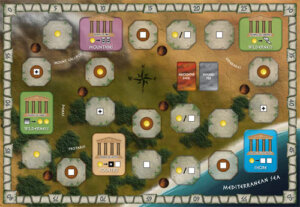
Each point you score moves your scoring token along the track around the board. Once the end game conditions are met, all the players total up the final score bonuses they get from Will cubes, coins, and treasure cards. You also lose three points for each despair cube you have. The player with the highest score wins the game.
Venture Forth was an interesting game. There are different strategies to explore, and it is possible to pull off a win at the last if you…Ahem…Play your cards right.
My problem was that I didn’t find it all that exciting. It got very repetitive after a while and it seemed like the game lasted too long. There isn’t a lot of interaction with the other players. I’m sure there are a lot of gamers that enjoy this type of game, but for my group we got bored, and by the end we were rushing to get the last explore token placed just so we could finish up the game. The game really has some interesting mechanics but there just wasn’t enough meat there to keep us going. I believe if there were a few more encounter types, and perhaps if adventurers could actually get killed rather than just penalized it would help. This is not a bad game; it just wasn’t up my alley.
[rwp-review id=”0″]
- A Dungeon Delve for Kids?: A Review of Dungeon! - Oct 24, 2022
- Better, Stronger, Faster | Descent: Journeys in the Dark Second Edition Reviewed - Oct 23, 2022
- Your Planet is Doomed!: Invasion from Outer Space Reviewed - Oct 22, 2022












